Theory
The Bingham distribution has the density function
\[ f(g;K,U) = _1\!F_1 \left(\frac{1}{2},2,K \right)^{-1} \exp \left\{ g^T UKU g \right\},\qquad g\in S^3, \]
where \(U\) is an \(4 \times 4\) orthogonal matrix with unit quaternions \(u_{1,..,4}\in S^3\) in the columns and \(K\) is a \(4 \times 4\) diagonal matrix with the entries \(k_1,..,k_4\) describing the shape of the distribution. \(_1F_1(\cdot,\cdot,\cdot)\) is the hypergeometric function with matrix argument normalizing the density.
The shape parameters \(k_1 \ge k_2 \ge k_3 \ge k_4\) give
- a bipolar distribution, if \(k_1 + k_4 > k_2 + k_3\),
- a circular distribution, if \(k_1 + k_4 = k_2 + k_3\),
- a spherical distribution, if \(k_1 + k_4 < k_2 + k_3\),
- a uniform distribution, if \(k_1 = k_2 = k_3 = k_4\),
The general setup of the Bingham distribution in MTEX is done as follows
cs = crystalSymmetry('1');
kappa = [100 90 80 0]; % shape parameters
U = eye(4); % orthogonal matrix
odf = BinghamODF(kappa,U,cs)odf = SO3FunBingham (1 → y↑→x)
kappa: 100 90 80 0
weight: 1Lets visualize the ODF as pole figures
h = [Miller(0,0,1,cs) Miller(1,0,0,cs) Miller(1,1,1,cs)];
plotPDF(odf,h,'antipodal','silent','layout',[1 3]);
and in Euler angle space
plot(odf,'sections',6)
The bipolar case and unimodal distribution
First, we define some unimodal odf
odf_spherical = unimodalODF(orientation.rand(cs),'halfwidth',20*degree)
plotPDF(odf_spherical,h,'antipodal','silent')odf_spherical = SO3FunRBF (1 → y←↑x)
unimodal component
kernel: de la Vallee Poussin, halfwidth 20°
center: 1 orientations
Bunge Euler angles in degree
phi1 Phi phi2 weight
156.958 161.468 197.878 1
Next, we simulate individual orientations from this odf, in a scattered axis/angle plot in which the simulated data looks like a sphere
ori_spherical = discreteSample(odf_spherical,10000);
close all
scatter(ori_spherical,'axisAngle')plot 2000 random orientations out of 10000 given orientations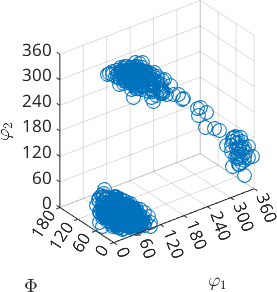
From this simulated EBSD data, we can estimate the parameters of the Bingham distribution,
odf_est = calcBinghamODF(ori_spherical)
plotPDF(odf_est,h,'antipodal','silent')odf_est = SO3FunBingham (1 → y←↑x)
kappa: 0 0.25 0.62 25
weight: 1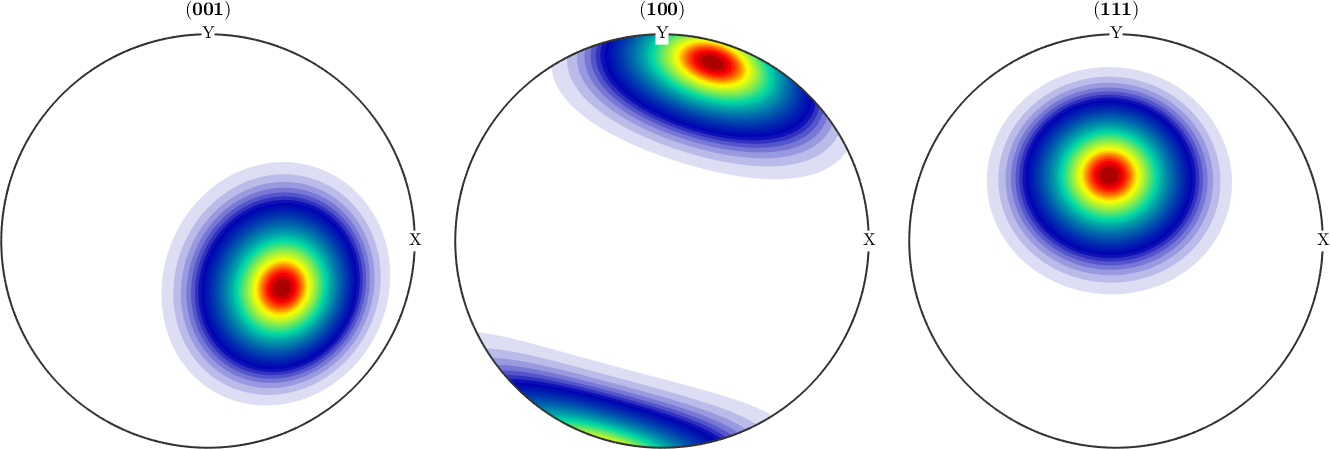
TODO
where U is the orthogonal matrix of eigenvectors of the orientation tensor and kappa the shape parameters associated with the U.
next, we test the different cases of the distribution on rejection
%T_spherical = bingham_test(ori_spherical,'spherical','approximated');
%T_oblate = bingham_test(ori_spherical,'prolate', 'approximated');
%T_prolate = bingham_test(ori_spherical,'oblate', 'approximated');
%t = [T_spherical T_oblate T_prolate]The spherical test case failed to reject for some level of significance, hence we would dismiss the hypothesis prolate and oblate.
%df_spherical = BinghamODF(kappa,U,crystalSymmetry,specimenSymmetry)%plotPDF(odf_spherical,h,'antipodal','silent')Prolate case and fiber distribution
The prolate case corresponds to a fiber.
odf_prolate = fibreODF(fibre.rand(cs),'halfwidth',20*degree)
plotPDF(odf_prolate,h,'upper','silent')odf_prolate = SO3FunCBF (1 → y←↑x)
kernel: de la Vallee Poussin, halfwidth 20°
fibre : (-771) || 11,4,3
weight: 1
As before, we generate some random orientations from a model odf. The shape in an axis/angle scatter plot reminds of a cigar
ori_prolate = discreteSample(odf_prolate,10000);
plot(ori_prolate,'axisAngle')plot 2000 random orientations out of 10000 given orientations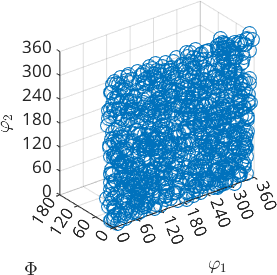
We estimate the parameters of the Bingham distribution
odf = calcBinghamODF(ori_prolate)
plotPDF(odf,h,'upper','silent')odf = SO3FunBingham (1 → y←↑x)
kappa: 0 1 48 49
weight: 1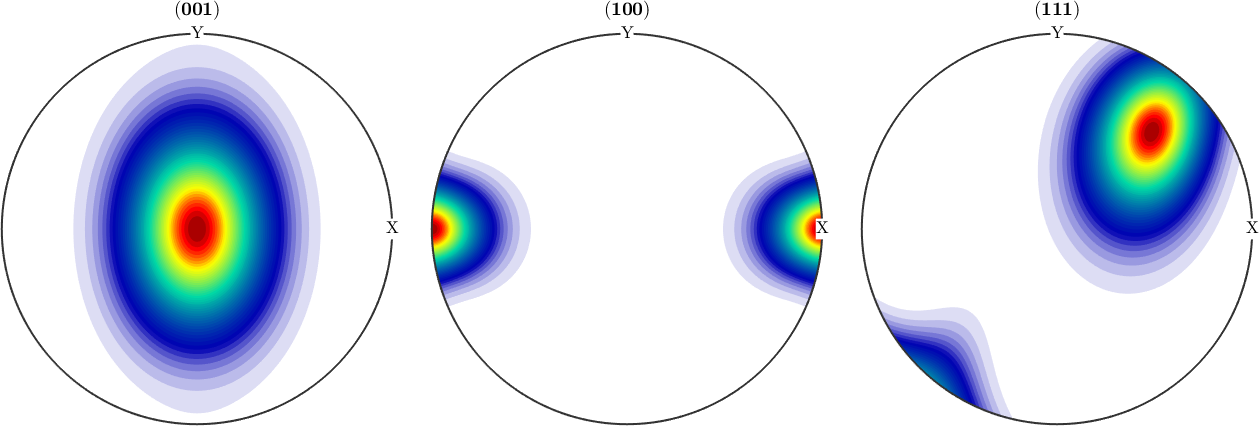
and test on the three cases
%T_spherical = bingham_test(ori_prolate,'spherical','approximated');
%T_oblate = bingham_test(ori_prolate,'prolate', 'approximated');
%T_prolate = bingham_test(ori_prolate,'oblate', 'approximated');
%t = [T_spherical T_oblate T_prolate]The test clearly rejects the spherical and prolate case, but not the prolate. We construct the Bingham distribution from the parameters, it might show some skewness
odf_prolate = BinghamODF(kappa,U,cs)
plotPDF(odf_prolate,h,'antipodal','silent')odf_prolate = SO3FunBingham (1 → y↑→x)
kappa: 100 90 80 0
weight: 1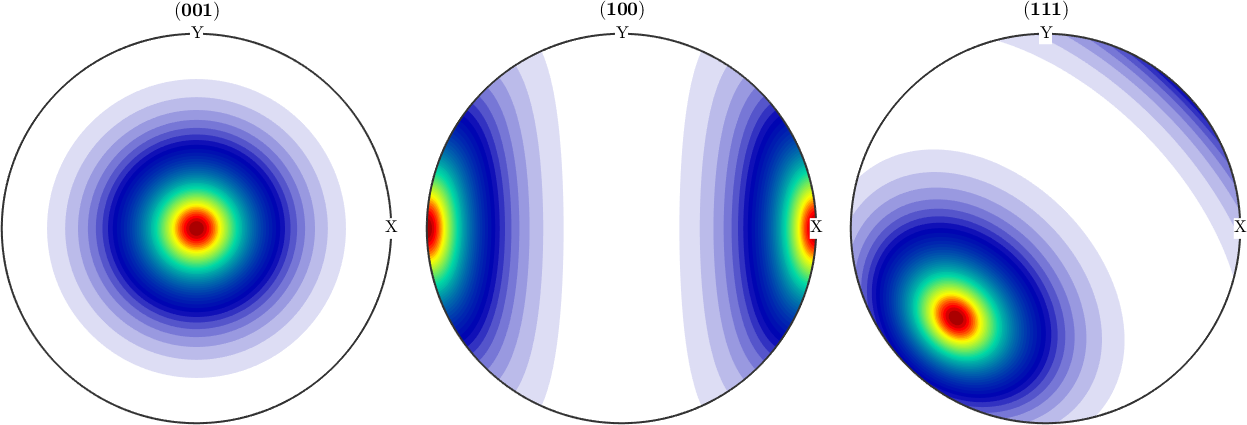
Oblate case
The oblate case of the Bingham distribution has no direct counterpart in terms of texture components, thus we can construct it straightforward
odf_oblate = BinghamODF([50 50 50 0],eye(4),cs)
plotPDF(odf_oblate,h,'antipodal','silent')odf_oblate = SO3FunBingham (1 → y↑→x)
kappa: 50 50 50 0
weight: 1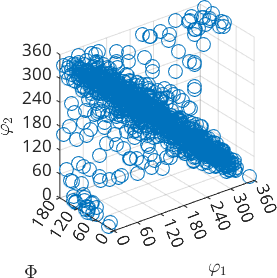
The oblate cases in axis/angle space remind on a disk
ori_oblate = discreteSample(odf_oblate,10000);
close all
scatter(ori_oblate,'axisAngle')plot 2000 random orientations out of 10000 given orientations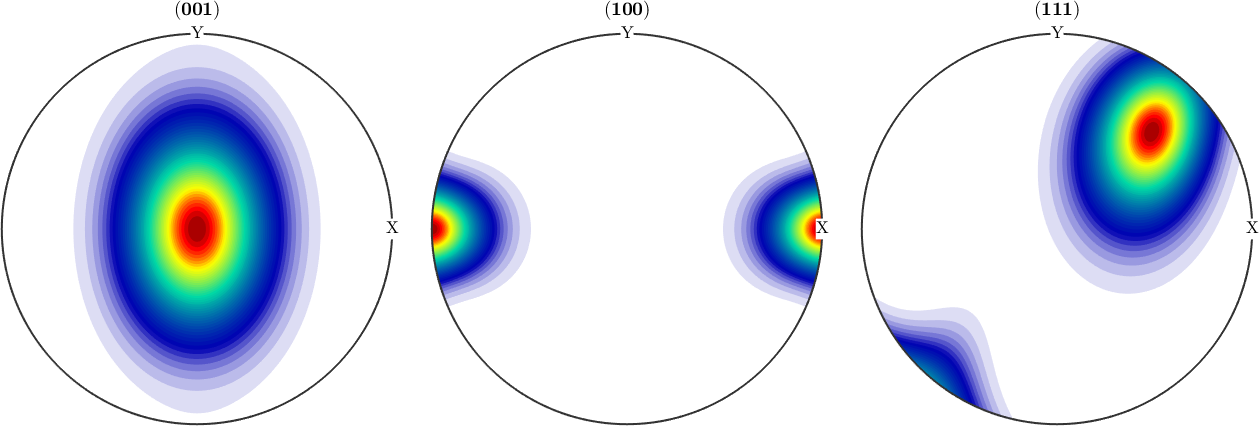
We estimate the parameters again
odf = calcBinghamODF(ori_oblate)
plotPDF(odf,h,'antipodal')odf = SO3FunBingham (1 → y↑→x)
kappa: 0 49 49 51
weight: 1
and do the tests
%T_spherical = bingham_test(ori_oblate,'spherical','approximated');
%T_oblate = bingham_test(ori_oblate,'prolate', 'approximated');
%T_prolate = bingham_test(ori_oblate,'oblate', 'approximated');
%t = [T_spherical T_oblate T_prolate]the spherical and oblate case are clearly rejected, the prolate case failed to reject for some level of significance
odf_oblate = BinghamODF(kappa, U,crystalSymmetry,specimenSymmetry)odf_oblate = SO3FunBingham (1 → y↑→x)
kappa: 100 90 80 0
weight: 1plotPDF(odf_oblate,h,'antipodal','silent')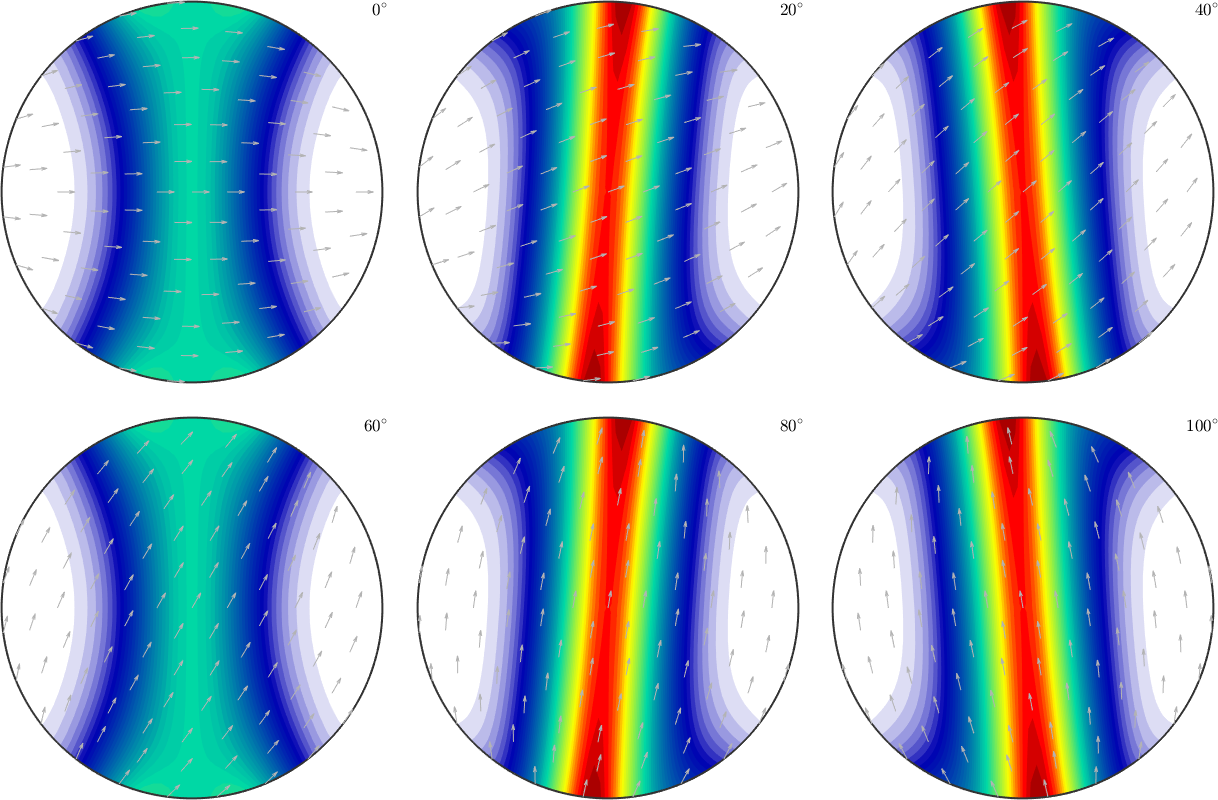
Bingham unimodal ODF
% a modal orientation
cs = crystalSymmetry('-3m');
mod = orientation.byEuler(45*degree,0*degree,0*degree,cs);
% the corresponding Bingham ODF
odf = BinghamODF(20,mod)
plot(odf,'sections',6,'silent','contourf','sigma')odf = SO3FunBingham (-3m1 → y←↑x)
kappa: 20 0 0 0
weight: 1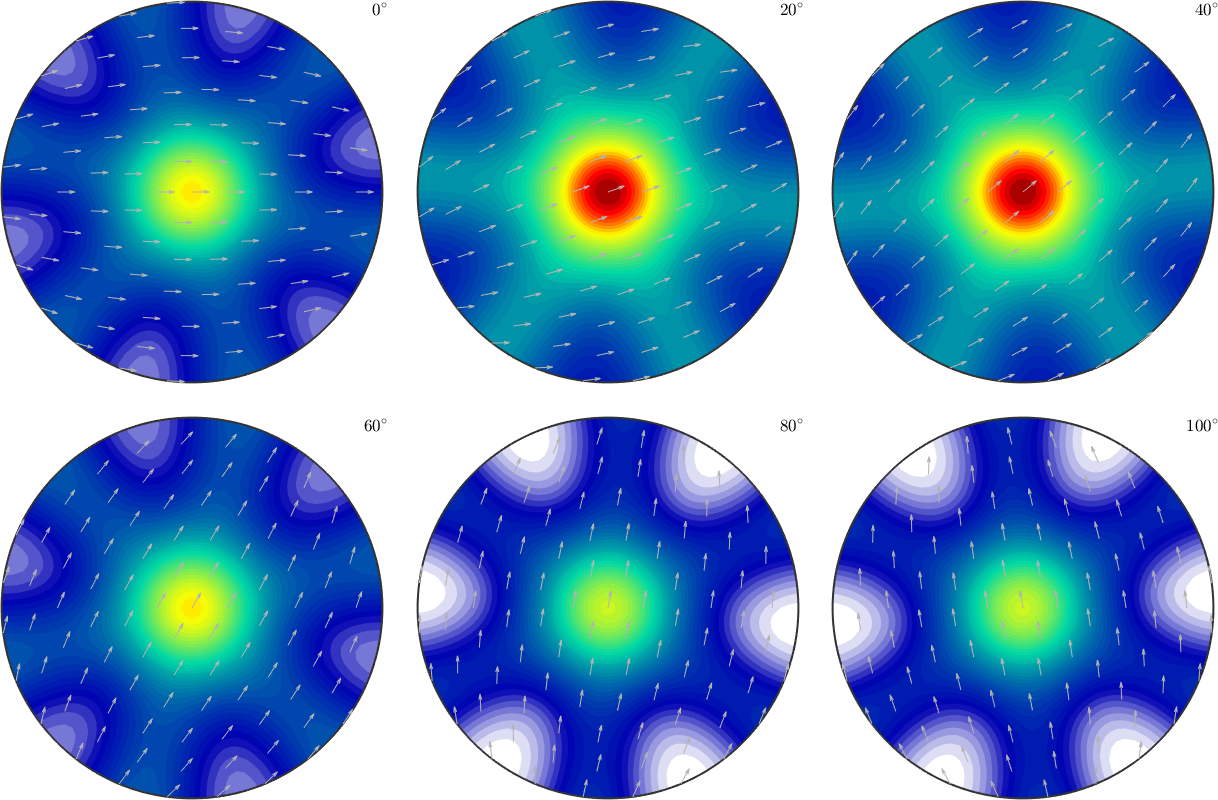
Bingham fibre ODF
odf = BinghamODF([-10,-10,10,10],quaternion(eye(4)),cs)
plot(odf,'sections',6,'silent','sigma')odf = SO3FunBingham (-3m1 → y↑→x)
kappa: -10 -10 10 10
weight: 1
Bingham spherical ODF
odf = BinghamODF([-10,10,10,10],quaternion(eye(4)),cs)
plot(odf,'sections',6,'silent','sigma');odf = SO3FunBingham (-3m1 → y↑→x)
kappa: -10 10 10 10
weight: 1